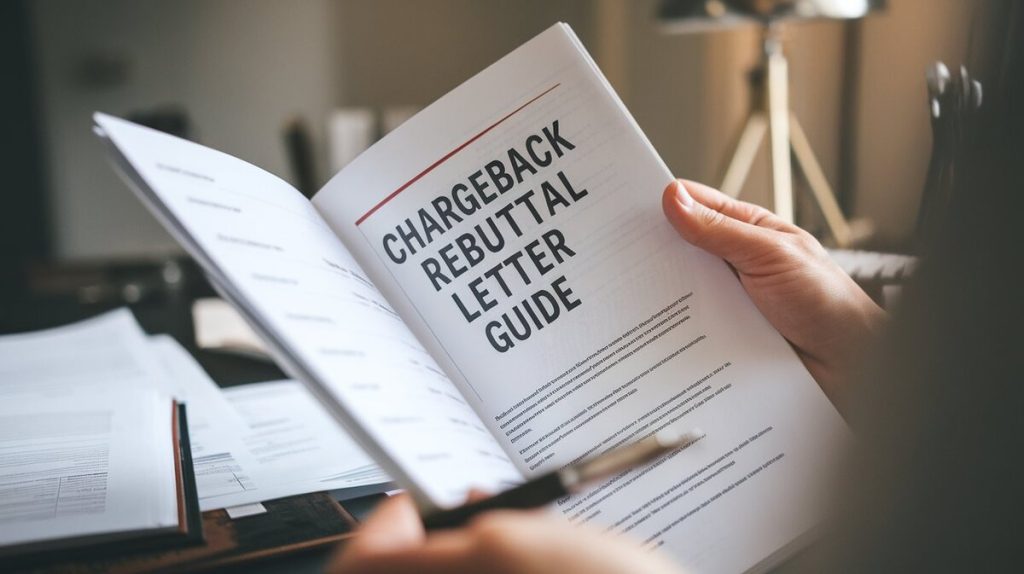Chargebacks are a significant issue for online businesses, with global chargeback-related losses estimated at $125 billion in 2021. For merchants, chargebacks represent both financial losses and potential damage to relationships with payment processors. A well-crafted chargeback rebuttal letter can help reverse unjust disputes and recover lost revenue. This guide outlines the essential steps to writing an effective letter, supported by data, facts, and a structured approach.
What is a Chargeback Rebuttal Letter?
A chargeback rebuttal letter is a formal response by a merchant to contest a chargeback filed by a cardholder. This document presents evidence that the transaction was legitimate and requests the chargeback to be reversed. According to Mastercard, presenting clear and well-organized evidence increases the chance of reversing chargebacks by 60%.
Key Elements of a Chargeback Rebuttal Letter
Each chargeback rebuttal letter should include:
- Merchant Information: Include your business name, merchant ID (MID), transaction details like the dispute ID, and the chargeback case number.
- Chargeback Reason Code: Always include the reason code for the chargeback. For example, Reason Code 13.1 refers to “Merchandise Not Received”.
- Summary of Transaction: State the transaction date, amount, and customer details. Include relevant transaction IDs to help match the dispute with the transaction in the card network’s system.
- Evidence: Provide supporting documents like sales receipts, delivery confirmations, and communication with the customer. Checkout.com reports that proper documentation increases the chance of success by 40%.
- Request for Reversal: Make it clear that you are seeking a reversal of the chargeback.
Below is a table showing key data fields to include in your chargeback rebuttal letter:
| Key Identifiers | Example Data |
|---|---|
| Merchant Name | ABC Electronics |
| Transaction ID | 123456789 |
| Chargeback ID | 9988776655 |
| Amount | $299.99 |
| Reason Code | 13.1 (Merchandise Not Received) |
| Case Number | 987654321 |
Step-by-Step Guide to Writing a Chargeback Rebuttal Letter
1. Provide Clear Contact Information
Include your business name, MID, and contact details. Ensure the accuracy of this information to avoid delays or dismissal due to incorrect data.
2. State the Dispute Reason Clearly
Describe the disputed transaction concisely. For example, if a product was not received, provide details of the order and delivery process:
“The transaction ID 123456789 was for a purchase made on June 5, 2023, valued at $299.99. The item was shipped on June 6, 2023, and the customer signed for delivery, as confirmed by the attached receipt.”
3. Present Strong Evidence
Support your claim with documents such as receipts, IP logs, and signed delivery confirmations. The VISA and Mastercard guidelines both emphasize the importance of relevant documentation in the success of a dispute. Braintree reports that disputes with well-organized evidence have a higher likelihood of being resolved in favor of the merchant.
| Type of Evidence | Example Documentation |
|---|---|
| Proof of Purchase | Digital sales receipt |
| Delivery Confirmation | Carrier confirmation receipt |
| Customer Correspondence | Emails or chat logs |
| IP Logs | IP address showing purchase location |
4. Avoid Emotion and Stick to Facts
Avoid emotional or accusatory language. Focus on providing factual information that clearly supports your case. Stripe advises that professional, well-organized submissions are 20% more likely to succeed.
5. Conclude with a Call to Action
End the letter by explicitly stating that you are seeking a reversal of the chargeback based on the evidence presented.
Example:
“We request that the chargeback be reversed based on the attached evidence confirming the legitimacy of the transaction and the delivery of the product.”

Common Mistakes to Avoid
- Being Vague: Avoid generic statements. Include all transaction details and relevant identifiers to support your claim.
- Missing Deadlines: Chargeback deadlines are strict. Mastercard and VISA require responses within 45 days. Submitting late can lead to automatic rejection.
- Inadequate Evidence: According to Braintree, submitting insufficient or incomplete evidence reduces the chances of winning a dispute by 25%.
Chargeback Success Rates by Industry (2023 Data)
The table below highlights success rates in chargeback disputes across different industries:
| Industry | Chargeback Rate | Reversal Success Rate |
|---|---|---|
| Retail | 1.9% | 60% |
| Travel | 2.5% | 50% |
| Digital Products | 3.1% | 55% |
How to Increase Your Chances of Winning a Chargeback Dispute
- Submit Early: Submitting documentation ahead of the deadline ensures that you have time for any clarifications or corrections. VISA recommends submitting at least 7 days before the deadline.
- Adhere to Payment Network Guidelines: Each card network has specific rules. For instance, Mastercard mandates physical signatures for some disputes, while VISA accepts digital confirmations in others.
- Use Expert Support: If chargebacks are a recurring issue, consider working with chargeback specialists. Merchanto.org, a partner of VISA and MasterCard in chargeback prevention, offers tools to reduce chargebacks and streamline dispute processes. Find out more about Merchanto.
- Analyze Your Chargeback History: Regularly analyzing past chargebacks can help identify patterns and take preventive measures. Checkout.com reports that businesses analyzing chargebacks monthly reduce disputes by 15%.

Example Chargeback Rebuttal Letter
Here is an example of a rebuttal letter for a merchandise not received dispute:
Subject: Chargeback Rebuttal – Transaction ID 123456789
Dear [Recipient’s Name],
I am writing to dispute chargeback ID 9988776655. This chargeback was filed under Reason Code 13.1 (Merchandise Not Received) for a transaction of $299.99 made on June 5, 2023.
I am providing the following evidence to support the legitimacy of this transaction:
- Proof of Purchase: Receipt showing the purchase made on June 5, 2023.
- Delivery Confirmation: Carrier receipt showing delivery to the customer.
- Customer Correspondence: Email from the customer confirming receipt of the item.
We request that the chargeback be reversed based on this evidence. Please contact me if further information is needed.
Sincerely,
[Your Name]
[Your Company]
[Your Contact Information]
How Chargebacks Affect Your Business
Beyond the immediate financial loss, repeated chargebacks can damage a business’s relationship with payment processors. Stripe and Checkout.com both report that a high chargeback ratio can lead to increased transaction fees or even termination of merchant accounts. Payment processors, such as Braintree, monitor the chargeback ratio and can suspend accounts with chargeback rates above 1%.
Conclusion
Writing a clear, concise, and well-documented chargeback rebuttal letter is essential for successfully disputing chargebacks and recovering lost revenue. Stick to the facts, avoid emotional language, and ensure you submit all required documentation on time. Regularly review chargeback patterns and adjust business practices to reduce future disputes.
Following these steps can help businesses improve their chargeback success rate and minimize financial losses. As chargebacks become more common, merchants must adapt by developing efficient processes for dispute resolution and prevention.



